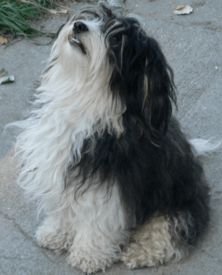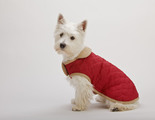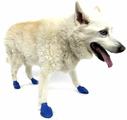
A distinctive breed developed from crossing European poodles with the Blanquito de la Habana, the Havanese began appearing in native Cuba in the 18th century, possibly introduced by Spanish settlers. A member of the Bichon family, the Havanese was the favoured breed of the Cuban aristocracy, but following the revolutions of Cuba, France and Russia, the Havanese faced extinction when breeding stock diminished. Introduced to America by Cuban immigrants, the Havanese began being bred in the 1970s and became a popular domestic and show dog. The Havanese was officially recognised by the American Kennel Club in 1996.
A dog of rugged appearance, the Havanese is easily recognised for its profuse corded coat in colours of silver, blue, black, cream, fawn, gold or tricolour. This is a compact dog with short legs, a full, slightly tapering muzzle, dark eyes, large pendant ears and a high-set tail that is carried high over the back. Further characteristic of the breed are its straight but un-level topline, which arches slightly to the tail end. Despite being considered a 'toy' breed, the Havanese is neither delicate nor fearful, but demonstrates independence and a willingness to learn. It is not in the nature of the breed to bark loudly or incessantly and it is relatively easy to house train when compared to other toy dogs. A smooth-coated variety, popularly termed the 'Shavanese,' is also recognised but is disallowed in the show ring.
Typically docile and affectionate, the Havanese makes a great addition to the home setting, whether for a family or a dedicated sole owner. Devoted to children, the Havanese will respond fearlessly if potential threat is perceived, whilst otherwise remaining calm and collected about the homestead. On average, a healthy Havanese at full maturity will weigh 3-6 kg, with a life expectancy of 14-15 years. It is common for the breed to outlive this expectancy.
A relatively long-lived breed, the Havanese is typically healthy and resilient. There are, however, a number of health complaints identified in the breed, ranging from mild to more serious. These include optical disorders, patellar luxation and dry skin, as well as kidney and liver complaints, cardiac disease and seizures. Deafness and orthopedic problems are also identified.








From Flintshire, United Kingdom
Havanese are brilliant family pets, highly intelligent, quick to learn, loyal, fun, non-shedding, happy dogs...... downside though... they are like Pringles once you've got one, you'll want another 😁
From West Midlands, United Kingdom
Havanese are great pets, my Teddy is a bundle of fun, full of character and really cute. Considering he’s a small dog he’s got a large personality.
From Hertfordshire, United Kingdom
Havanese are the greatest gift. I was a large dog person until meeting my Max, he has the get up & go of a large breed, loves to walk forever too. Havie’s communicate w their eyes, and you always know what they’re asking or saying to you. I will always have a Havanese in my life!
From Midlothian, United Kingdom
Mela is wonderful dog, family oriented, intelligent, eager to play, learns very quickly. Is the most wonderful dog I have ever had 😁👍😍